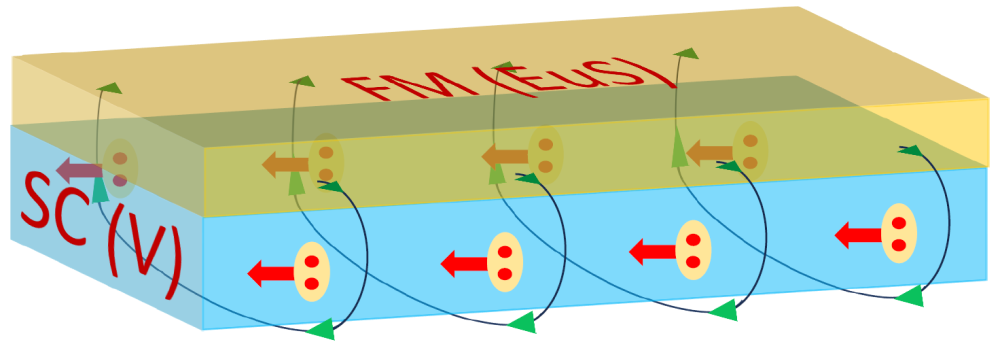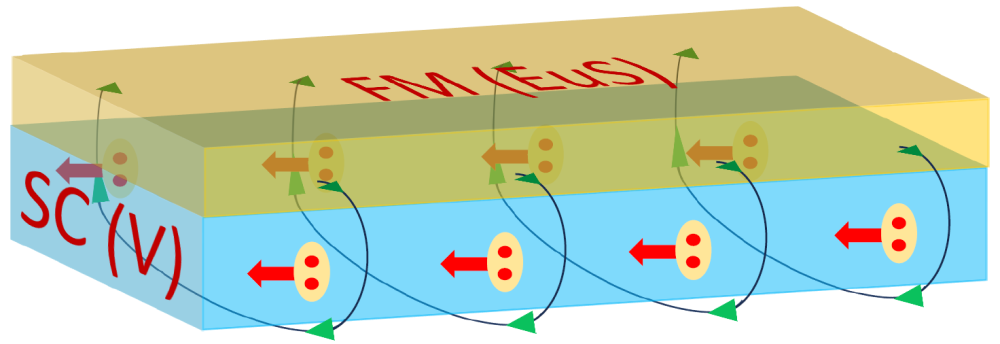A More Efficient Superconducting Diode
Semiconductor diodes conduct current in one direction but not the other, giving them myriad applications in electronics. Their one-way property is made possible by a difference in the conducting behavior of the two types of charge carriers—electrons and holes. Superconducting diodes could also be useful in sensors and other devices. But because supercurrents have just one type of carrier—electrons in so-called Cooper pairs—realizing a superconducting diode is more difficult. In 2020 researchers demonstrated a diode effect in a superconducting device made from a layered material that required precise stacking, strong spin–orbit coupling, and a unique form of Cooper pairing [1]. Now Jagadeesh Moodera from the Massachusetts Institute of Technology and collaborators have made a superconducting diode that is more effective, simpler in design, and independent of esoteric electronic effects [2].
The team’s diode design consists of a thin strip of either niobium or vanadium. Unlike most single-element superconductors, niobium and vanadium are both type II superconductors—which means that an applied magnetic field of the right strength induces the formation of vortices of supercurrent that all rotate in the same sense. Moodera and colleagues applied such a field perpendicular to the surface of their device, inducing vortices within the strip, as well as supercurrents (called Meisner currents) along the edges of the strip. Viewed from above, one edge current flowed to the right (in the “forward” direction), the other to the left (in the “reversed” direction). The researchers then sent an external current across the ends of the strip—both in the forward and reversed directions—and measured the net current for each case.
In principle, the counterpropagating edge currents are equal, so their contributions to the net current should cancel out. But in practice, fabricating a strip inevitably results in structural differences between the two edges. That accidental asymmetry, the MIT team found, was large enough to result in a diode efficiency of 20%—defined as the difference between the forward and reversed net currents, divided by the sum. The researchers found that they could boost the diode efficiency to 50% by deliberately adding notches to one of the edges. But they obtained 65% efficiency, the largest value seen so far, by replacing the applied magnetic field with the intrinsic field from an overlayer of a ferromagnetic insulator, europium sulfide.
In effect, Moodera and his colleagues have demonstrated that a giant diode effect is present in ordinary superconductors that results from the breaking of simple, geometric symmetry. Such superconducting diodes could find immediate use in superconducting electronics and future use in superconducting or topological qubit circuits, Moodera says.
Philip Moll studies quantum materials at the Max Planck Institute for the Structure and Dynamics of Matter in Germany. He points out that the observation of a large diode effect in single-element superconductors is significant because their simplicity will make applications easier and more scalable. “The beauty of Moodera and colleagues’ work is that they obtained record efficiencies without even trying,” he says. “Their structures are far from optimized yet.”
–Charles Day
Charles Day is a Senior Editor for Physics Magazine.
References
- F. Ando et al., “Observation of superconducting diode effect,” Nature 584, 373 (2020).
- Y. Hou et al., “Ubiquitous superconducting diode effect in superconductor thin films,” Phys. Rev. Lett. 131, 027001 (2023).





